How to Start Email Marketing
Email isn’t going anywhere. There are currently 4.3 billion email users worldwide, with that figure predicted to rise to 4.3 billion by the end of 2025. Furthermore, this communication platform is extremely popular: people check their emails several times a day, and if you’re trying to market your business, you can get your name into thousands of inboxes simply by launching an email marketing campaign.
Cost-wise, email marketing is also very affordable, making it ideal for small businesses. However, simply sending an email supporting your company is insufficient. Every day, people are bombarded with promotional emails, and many of them are removed without being read. That is why you must ensure that your emails stand out from the crowd.
So, where can you begin, and what can you do to make your first email campaign a success? Let’s get started: Here’s how to start your first email marketing campaign, which will increase engagement and sales for your business.
Reasons Why You Should Make Email Part Of Your Marketing Strategy

You cannot afford to neglect email marketing, whether you are a novice marketer or a bigwig entrepreneur. The following are three compelling reasons why you should integrate email into your marketing strategy:
- The demise of pop-up and banner ads created a void that only email marketing could fill. As interactive and personalized marketing became more commonplace, email as a distribution platform increased in popularity.
- When used correctly, email marketing is proven to be successful. An email campaign must strike a delicate balance between too much and too little.
- Email marketing has become an indelible part of the online experience for consumers. Marketing emails now have real value to the target market, thanks to improved algorithms that screen out spam and phishing emails.
Email marketing is constantly evolving. The methods used to execute it, as well as how they work, are continuously evolving. In this article, we’ve put together everything you need to know about harnessing the power of email into seven simple steps.
How To Get Started With Email Marketing
Step 1: Determine Your Objectives

The first step is to determine your objectives. To be successful with email marketing, you must first identify your goal (s). Since email marketing is the most effective tool in the sense of your overall marketing objectives, it’s critical to set goals that are achievable while still propelling your overall strategy forward.
The key to establishing the right priorities is to match them with your company’s entire marketing environment and key performance indicators (KPIs). Your objectives should be focused on the consumer, campaign-specific, and engagement-driven. Set targets that you can accomplish gradually and expand on previous efforts. It will then be easier to decide whether your campaign is bringing you closer or further away from your target.
To help determine your goals, a few good questions that can help you structure your campaign are:
- Who are you sending emails to?
- What is the reason for sending them emails?
- What types of emails will you send?
- How often will you send the email?
- How do you want the email to look?
Take the time to strategically organize your thinking and be transparent and precise with your answers. Email campaigns may have several targets, but knowing what the top priority is and maintaining the attention at all times is key to email marketing success.
Step 2: Grow Your List
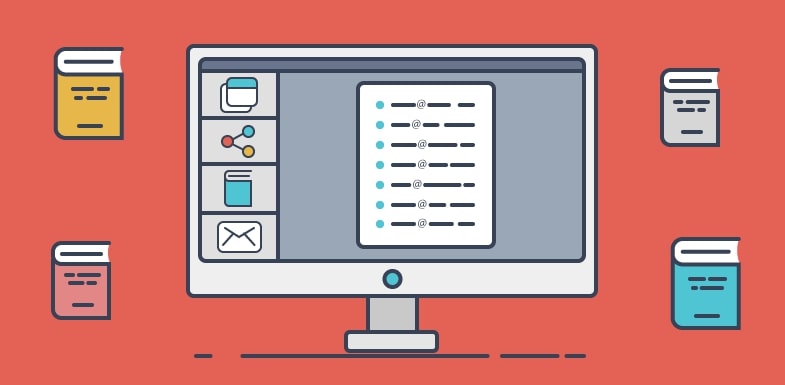
Building an email list can be a daunting task for both newcomers and seasoned email marketers. Since your list can be monetized, the more subscribers you have, the better. This is why brands devote so much time and effort to acquiring new leads.
It’s worth the effort, but having people to send you their email address can be difficult. In reality, 61 percent of marketers claim generating leads is their most difficult challenge.
There are many methods for expanding the email list. One of the most common is creating lead magnets. A lead magnet does just as it sounds like: it attracts new subscribers. A lead magnet can be:
- A free eBook.
- A downloadable checklist.
- A free mini-course.
These are just a few examples, but they all have one thing in common: they’re all free. You have something of value in return for their email address. The best thing about lead magnets is that you can set them up once and then leave them to work in the background. Unless they are time-sensitive, they will continue to collect leads for you with no extra work from you. Isn’t that amazing?
P/s: don’t buy email lists
If you’ve done some research on this, you might have discovered that you can buy email lists. To put it another way, you pay for people’s email addresses without having to do anything to obtain them.
Although this may sound appealing, we strongly advise you to avoid it. For instance, experts generally regard it as black hat. Second, they are frequently not qualified/quality leads, which means they are not people you can convert into loyal followers and, finally, customers. They are unlikely to be targeted, and they are not your target audience.
Furthermore, the majority of companies that offer email lists only provide basic information such as age and location. This is ineffective for a message-focused email campaign. Be certain that you are expanding your list with the right people. Your email marketing efforts would be futile if your recipients are not actively engaged with you or interested in what you have to offer.
Sending relevant content to the right audience would significantly improve interaction. Organically building an email list can take time, but it will yield better results over the long run and allow you to deliver the right content to the right people. Furthermore, you would not be in violation of any data privacy rules.
Step 3: Invest in a Quality Email Marketing Platform

Yes, you’ll want to spend at least some money here. But don’t worry, these tools can be affordable and well worth the money. Consider this. You don’t want to have to send email content to each subscriber individually. In a matter of minutes, you can use email marketing tools to build automations and send emails to entire list segments (more on that in a moment). This is not only more efficient, but it also allows you to gather information and data on your subscribers to help you develop your email strategy. We’ll go through this more in a second.
The ideal tool for you will be dependent on your budget and the type of business you run. For example, an eCommerce company will need email marketing software that takes into account the fact that they are selling products online. Fortunately, there are a variety of platforms available for a wide range of companies with varying budgets. If you have just $9 to spend per month or $1,000, there is a tool out there that is ideal for your brand.
Read more: Top 8 Best Email Marketing Platforms
Step 4: Segment Your Subscribers

Is it true that every email subscriber is the same? Obviously not. So, why would you treat them all the same? To prevent this, you can segment your subscriber list, which means you divide them into distinct categories so that you can offer tailored content to each of them.
Assume you earn a subscriber as a result of someone downloading your free eBook. Let’s say you get another as they signed up for a discount code. The first subscriber will have a better experience because he or she receives more free material, while the second will benefit from future discounts and promotions. The point is to provide content that is meaningful to the individual.
Don’t group all of your subscribers together. Segment them instead. Email marketing is critical to the overall digital marketing plan, even though it does not sound like instant gratification because it is a long-term approach. Begin working on it right away, because email isn’t going away any time soon.
Step 5: Create Targeted Content

The type of email campaign you can send to your subscribers will be determined by the marketing objectives you set in the first phase of this process. To help you get started, here are five common forms of email content that you can consider using in your email marketing campaign.
Marketing Offers
When an individual signs up to receive marketing emails, they expect rare, even personalized deals. Consider having marketing offers that highlight the most recent and updated items, exclusive sales, deals, or offers in your campaign.
Ebook or Software Download
Many people who read marketing emails in their inboxes would like to get more information on the topic that they are interested in. You can take advantage of this to produce value-packed ebooks that promise to increase the subscriber’s quality of life. Inexperienced marketers often underestimate the inherent value of an ebook to a subscriber. If you sell software and want to offer free trials to your customers, you can do so via email marketing too.
Newsletters
A newsletter is an email to subscribers that usually focuses on a single subject of interest. Newsletters may be issued on a daily or irregular basis, depending on the ‘news’ your company wants to inform. Newsletters are often simple, clean and succinct, and relevant in order to provide value to the recipients.
Announcements
Announcement emails are often used to announce the launching of a new service, feature, or product. It differs from a newsletter in a way that it prompts the recipient to take action, such as reviewing the most recent product, taking advantage of an expiring discount, or spreading the word to their contacts.
Step 6: Execute your campaign
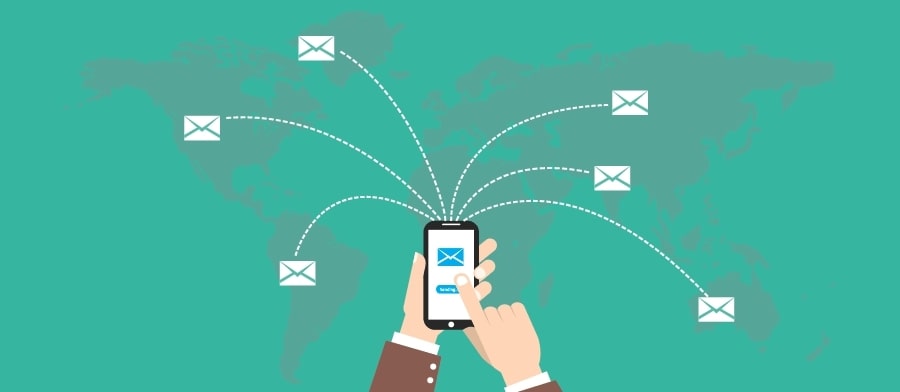
There’s no need to reinvent the wheel when it comes to launching your email campaign; email marketing tools are here to help. Email marketing tools make it simple to build engaging and professional email templates while still helping you keep track of the campaign. Here are a few of the most important things you should know to get the most out of your marketing campaigns.
When it comes to SEO and content marketing, you’ve probably learned that content is king. The same is true for email marketing. According to data, the average internet user’s attention span is eight seconds. Marketers must produce marketing content that is easy to skim through in order for the reader to grasp the “gist” of the email before the recipient loses their interest.
Design a simple email
According to data, approximately 40% of marketing emails are opened on a mobile device. Your campaign’s email design must be open to both large and small screen devices. The right marketing software will assist you in creating properly optimized email templates with the right buttons and text placement.
The clarity of your words should compliment the nuance of your call to action. Simple emails most of the time perform better than complicated emails that contain overlapped and unstructured content.
Boost engagement with images, visuals, and videos
When we talk about email copies being simple, we don’t mean boring. Above all, graphics should make your marketing emails stand out from the crowd. Make your marketing copy come to life with meaningful graphics, enticing graphs, and easy-to-digest visuals. Color graphics in marketing emails are not only eye-catching, but much more memorable. You can add links to your YouTube channel and videos, but embedding the actual videos in the email body is not a good idea.
Step 7: Understand Your Analytics

A successful marketer recognizes the value of email analytics. Analyzing analytics allows you to test email campaigns, evaluate the outcomes, expand your email list, and increase conversions. Although this may seem to be a challenging task, calculating the effectiveness of your email marketing campaigns does not have to be difficult. To get started, you just need to know the fundamentals.
Let’s take a quick look at some of the most important metrics used by marketers:
- Open rates are the percentage of recipients who open your email compared to the total number of recipients.
- Click-through rates are the number of recipients who click on links in your inbox.
- Unsubscribe rates are the number of people who want to be removed from your mailing list.
- The number of addresses on your email list that are declined by the recipient’s email server is referred to as the bounce rate.
Digging under the surface is the secret to make progress. It is not just about making visually appealing and elegantly worded emails. It is about taking into account what the data tells and using it to strengthen the approach.
Read more: 10+ Most Significant Metrics in Email Marketing That Any Online Stores Must Keep An Eye On
10 Types of marketing emails
1. Welcome emails
In theory, welcome emails are rather simple. When someone joins your mailing list, you send them a welcoming email to thank them, let them know what to expect, and perhaps even offer a freebie. The nice thing about welcome emails is their generally high open rates, which is why brands like Slack employ them:
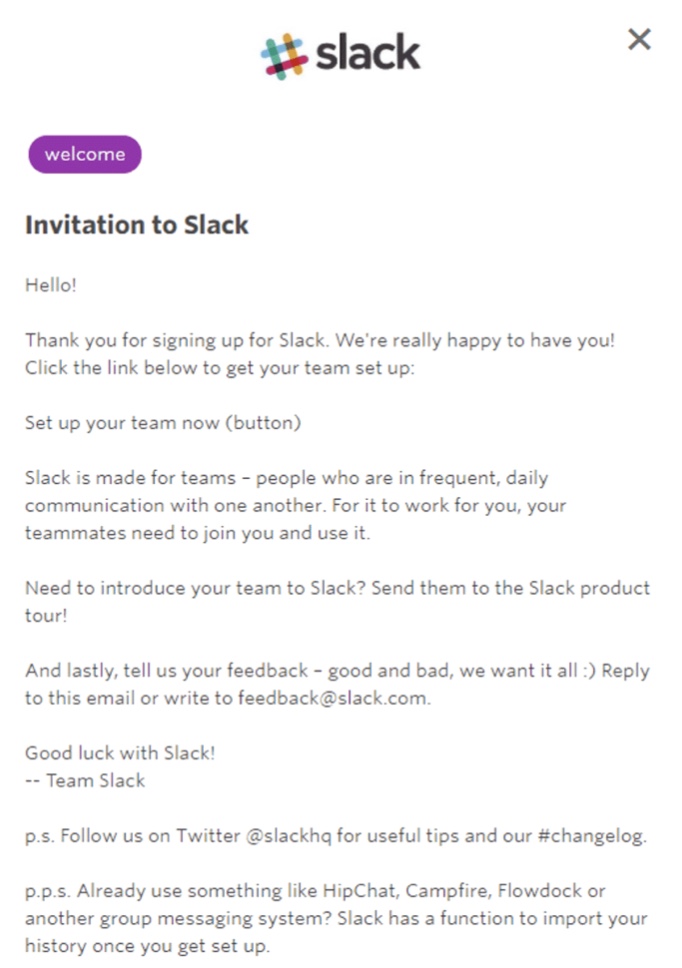
This example contains a lot of information to unpack, but that is to be expected from a service like Slack. They do, however, touch numerous essential points, including:
- The quick “Thank You!” for registering.
- A Call to Action (CTA).
- More information about the product and the resources that are accessible to the subscriber.
Because welcome emails are so appealing, it doesn’t make sense to waste them with a mere “Hello.” Use them to notify subscribers of all important information, and if you have the time, consider a comprehensive welcome email series instead of a one-off.
2. Product feedback emails
Any product or service can benefit greatly from customer feedback. Getting individuals to leave you reviews, on the other hand, takes a lot more effort than you might imagine. Email is a terrific approach to obtain more feedback.
Not only is feedback necessary for product development, but it also lets your subscribers know that their opinions are valued, which can increase engagement. However you should avoid extremely thorough questionnaires and keep your product feedback messaging more casual (like Headspace does!).
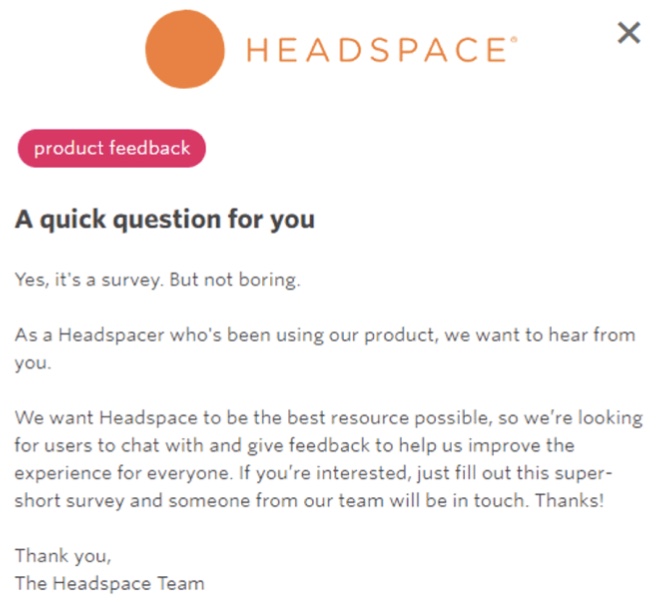
3. New feature updates
Updates to your products or services are a terrific method to keep customers pleased while also generating new interest in them. Whatever such updates entail, you should always notify your subscribers via email:
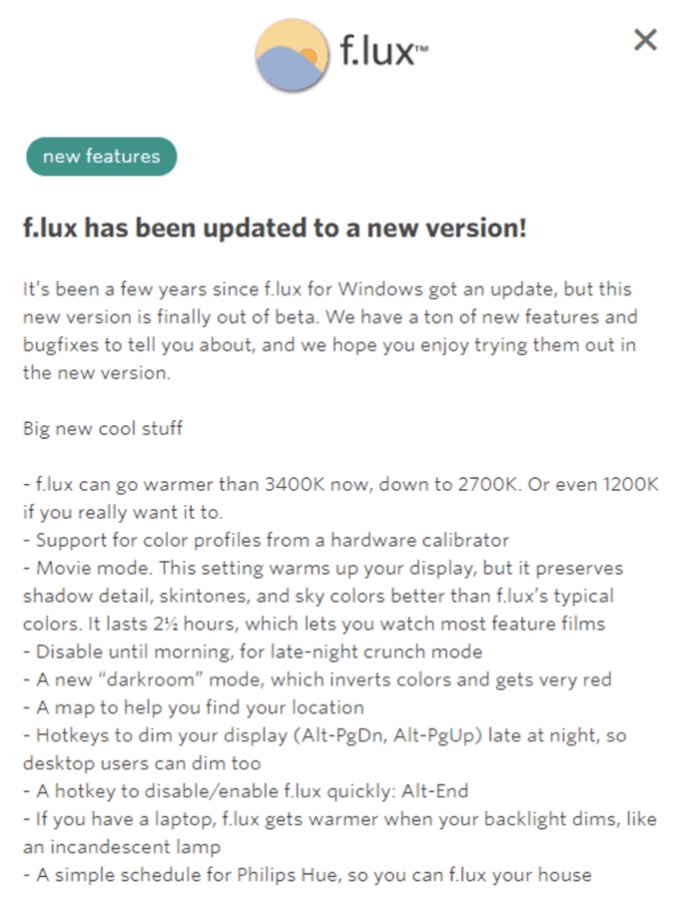
This is one of the few types of email marketing campaigns where we encourage including as much info as possible is new feature updates. That way, you’ll be able to answer as many inquiries as possible right away, and your most devoted subscribers will be pleased.
4. Subscription Confirmation emails
Let’s face it: subscription confirmation emails — the ones you get after you join up for a new list – aren’t glamorous, but they’re necessary. If you’re anything like us, you despise email spam, therefore obtaining permission from your subscribers is critical.
With email confirmation messages, you ensure that everyone on your list truly wants to be in it. As a result, you will have more precise analytics and your conversion rates will remain higher.
5. Holiday-related emails
Holidays, such as Christmas, are excellent for marketing, especially email. They not only allow you to convey your best wishes to your subscribers, but you can also utilize them to drive more conversions, share crucial news, or simply have some fun.
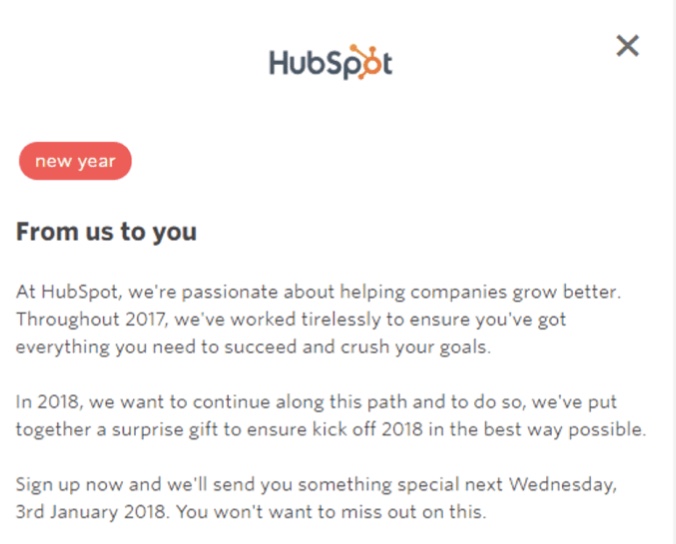
Hubspot, for example, used its New Year email to introduce new features. This is a terrific concept because more consumers are likely to skim these kinds of communications around the holidays, resulting in increased exposure.
6. Thank you emails
We’ve all got a family member who is always sending ‘thank you’ notes. They not only demonstrate good manners, but they are also a fantastic method to gain goodwill. The same is true even if the thank you messages are digital.
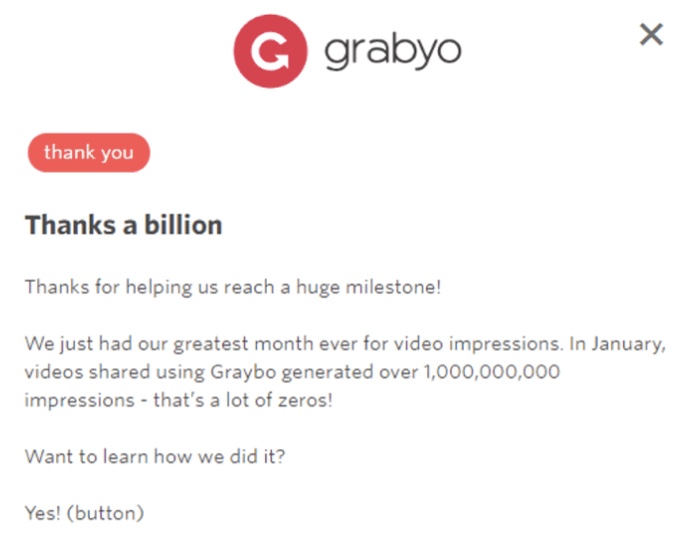
However, with email marketing, you can send thank you messages for almost anything. Companies like Grabyo, for example, use them to commemorate special occasions. Another method, similar to Trello, would be to utilize these emails as an occasion to share freebies.
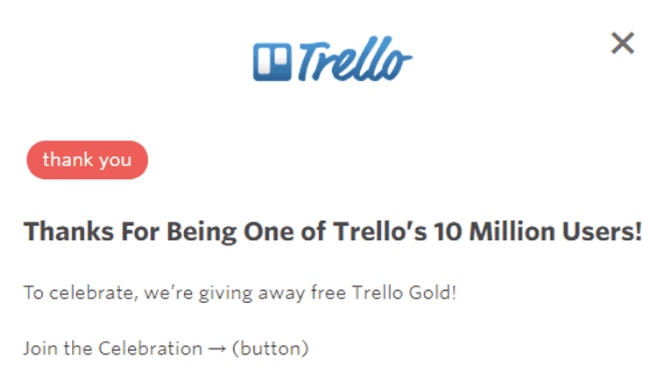
In any case, these kinds of emails are all about the customer, so you shouldn’t use them to market products or services this time.
7. Nurturing emails
Many people sign up for email lists but never check any of your emails or use your services. Rather than taking it personally, contact out to see if there is anything you can do to help them out or otherwise improve your marketing. This is referred to as a ‘nurturing’ email.
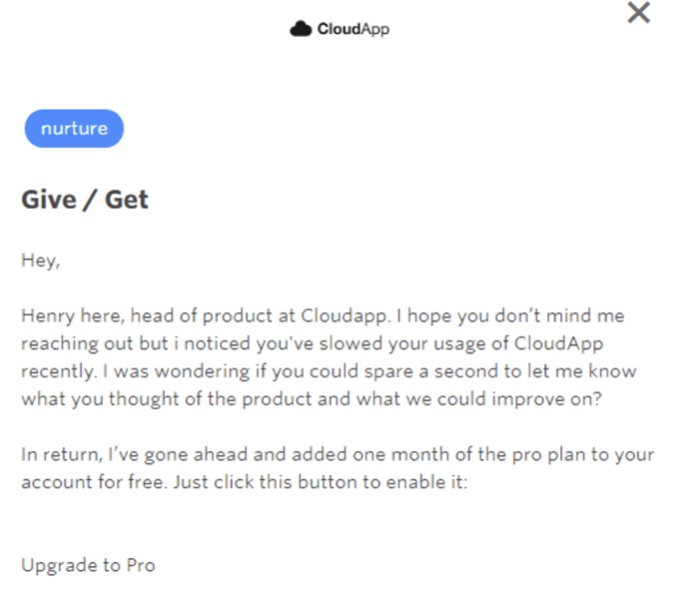
This CloudApp example is nearly perfect since it has a really personal feel — like a friend reaching out to see whether everything is all right. At the same time, they provide a free month of subscription in the hopes that the user may return if they have discreetly ‘ghosted.’
A gentle touch is preferable when it comes to nurturing emails. Don’t attempt to push conversions too hard. Instead, concentrate on what you can do to improve the user experience.
8. Milestone emails
Whatever type of business you manage, there will be several turning points along the way. Each one provides the ideal opportunity to reach out to your subscribers, brag about yourself, and thank them while you’re doing it:
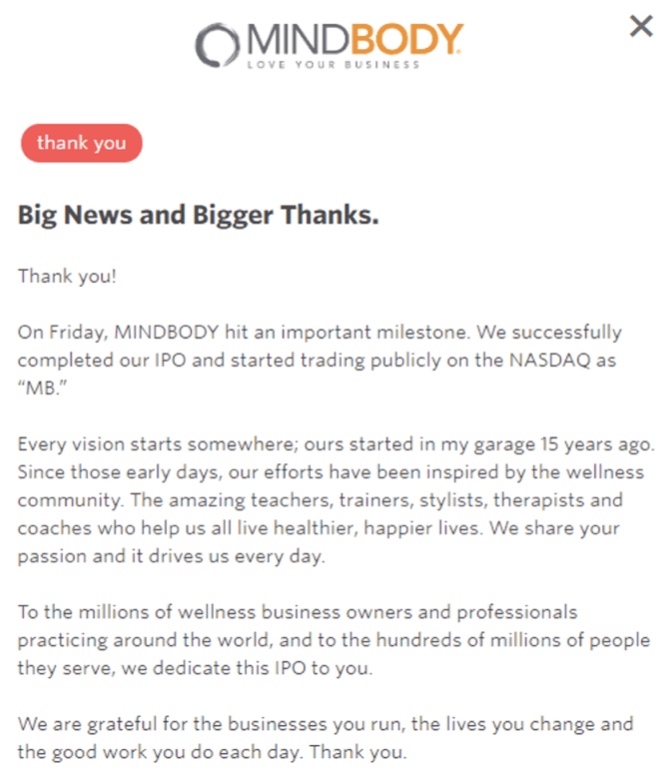
Milestone messages are excellent ways to engage with your subscribers. You can discuss your company’s goals, upcoming updates, how you can support your customers, and a variety of other topics.
9. Newsletters
Newsletters are possibly the most common sort of email marketing campaign. For example, if you run a blog, you’re probably going to send out a lot of newsletters about your content:
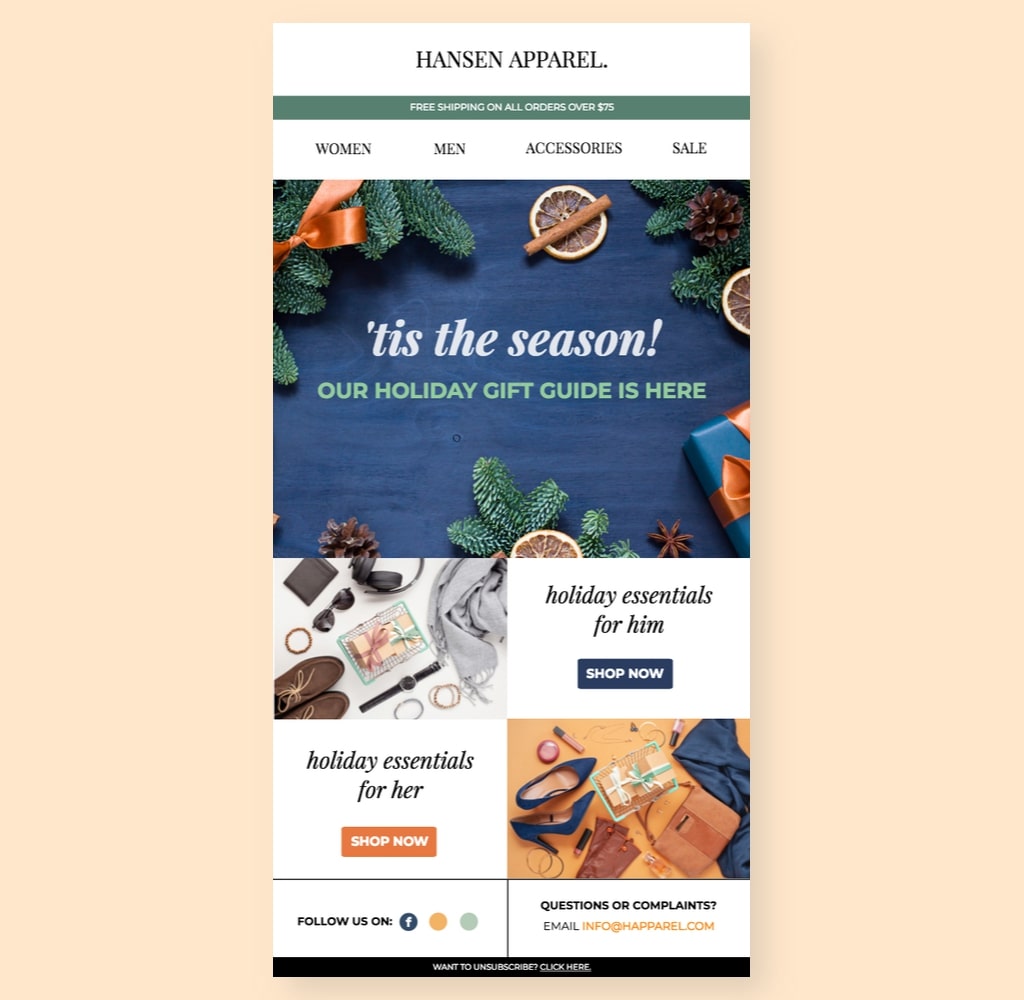
Only your most ardent subscribers will return to your site on a frequent basis. With newsletters, you can inform everyone about what they’re missing and encourage more return visitors.
10. Gift emails
A freebie is something that everyone enjoys. That’s why so many websites (including ours) provide free e-books and instructions in exchange for signing up for their email lists (as you’ll see at the end of this post!). However, if you want to spread the love, you can send a present to your existing members on occasion.

A freebie does not have to be a particular item or service. You can offer subscribers discounts on future purchases, a freebie if they purchase specified things, and more. The idea with this type of email is to begin with your offer and explain what value it brings them, so it doesn’t feel like you’re ‘tricking’ them.
What’s the average email marketing ROI?
According to a DMA report from 2019, the average return on investment for email marketing is 42:1. According to statistics, if you put $1 in email marketing, you will receive $42 in return.
Of course, this is an average, not a fixed number. The return on investment in your firm will be determined by a variety of criteria, such as:
- content relevance
- size and quality of your email list
- design and copy
- call to action
- etc.
One of the most significant benefits of email marketing is the ability to track success and show data to demonstrate ROI. This is especially critical if your marketing budget is limited and every decision you make must be data-driven.
How to measure email marketing ROI?
Typically, calculating the return on investment in your email marketing initiatives is simple. All you have to do is keep track of overall revenue and divide it by total cost.
As an example, suppose you made $100 in sales and spent $30 on an email marketing campaign. You will calculate the ROI of your campaign as follows:
Total revenue is $100 – $30 = $70
Total spend is $30
So ROI is ($70 ÷ $30) * 100 = 233%
That is a straightforward method for measuring your accomplishment and obtaining further budget for future campaigns. Naturally, if you consider other expenditures, such as your employees’ time or the cost of producing the things you’re selling, the equation can become more complicated.
How to grow your email list
One of the most important continuous tasks of an email marketer is list building. You want to build a huge and engaged audience so that you can reach them directly in their email inboxes.
You can grow an email list in a variety of ways. Let’s take a look at the key strategies and methods for acquiring a high-quality list.
1. Lead magnets
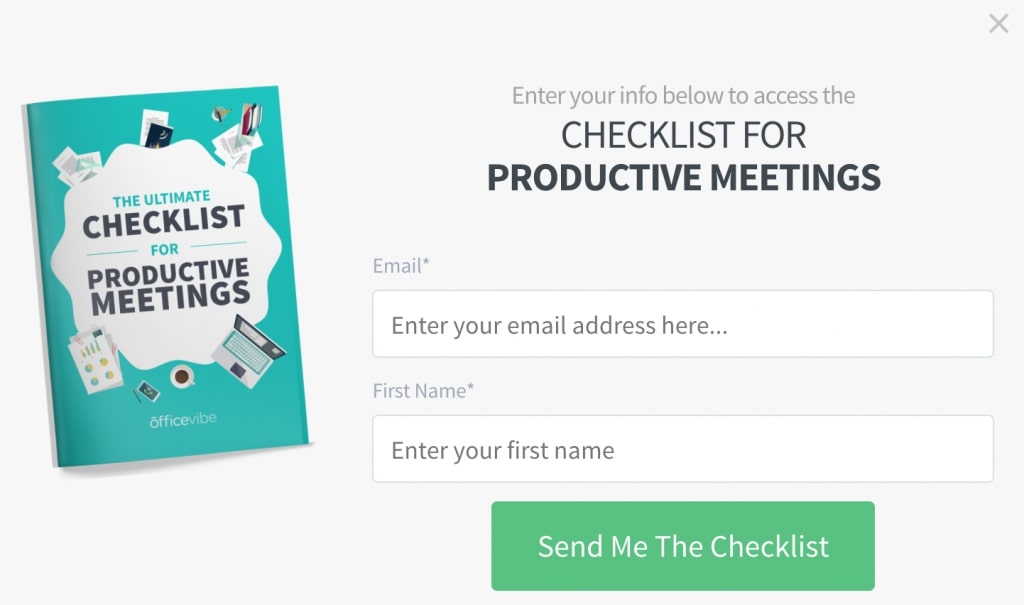
To persuade your target audience to join your email list, you need to first present a compelling reason for them to do so. Most individuals will want something in exchange for their time and the ability to contact them immediately from their mailbox. This is where lead magnets come into play.
A lead magnet is an incentive you provide in exchange for your website visitor’s email address. Lead magnets are most typically in the form of an ebook, a checklist, free trial or a free tool, etc.
According to a recent survey, marketers saw the highest conversion rates with video (e.g., webinars) and written type (e.g., manuals) lead magnets.
That is not to argue that other types of incentives should not be used. Depending on the industry you’re in, the type of subscribers you’re trying to acquire, or the purpose of your email marketing campaign, you’ll want to employ a range of different lead magnets.
2. Optin forms
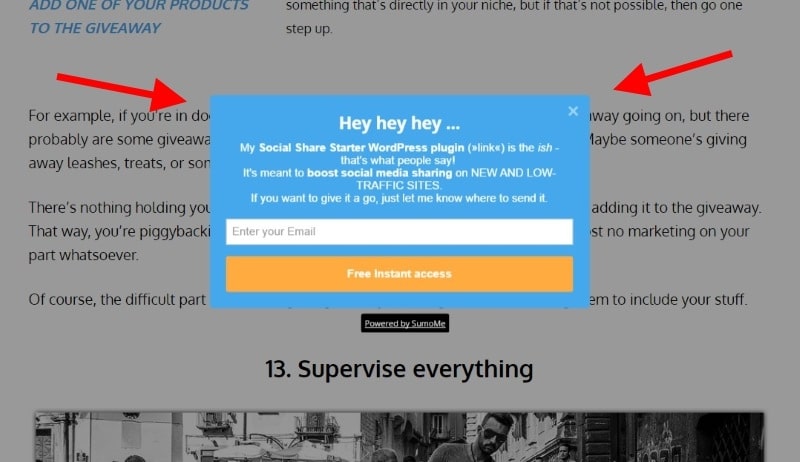
An optin form, also known as a web form or signup form, is an HTML form that is placed on a website to allow people to sign up. This is the primary method you should employ to generate leads. There are various types of optin forms that you can utilize. The distinction between them usually comes down to how or when they display in front of your visitor’s eyes.
The most common types of web forms are:
- Popups and lightboxes
- Embedded/Inline web forms
- Scroll forms
- Exit intent forms
- Fixed bars
- Click forms
- Welcome mats
You should utilize a range of various types of forms on your website. The bare minimum is to have an embedded form on every page of your website and pop-up forms on the sites that receive the most traffic.
Consider what information you’ll need to execute an successful email marketing campaign while building your web forms and selecting your lead magnets.

It may be tempting to request more information from your audience (for example, their company name, website URL, or budget), but the more information you want, the fewer people will fill out your form. Each additional input field reduces the conversion rate of your subscription form.
At the same time, you won’t want to end up with a large number of email addresses from people who aren’t in your target demographic.
Another important consideration is user experience. By displaying too many details, you risk detracting from your website visitors’ experience and discouraging them from returning in the future. To avoid this, keep an eye on who sees your forms and maybe limit pop-ups to only appearing after users have spent a decent length of time on your site.
3. Landing pages
Most websites and homepages have many goals to achieve. They are intended to provide information for all types of visitors who join the website, and as a result, they are frequently rather cluttered. They are also not intended to efficiently convert email subscribers. This is why marketers create specific landing pages.
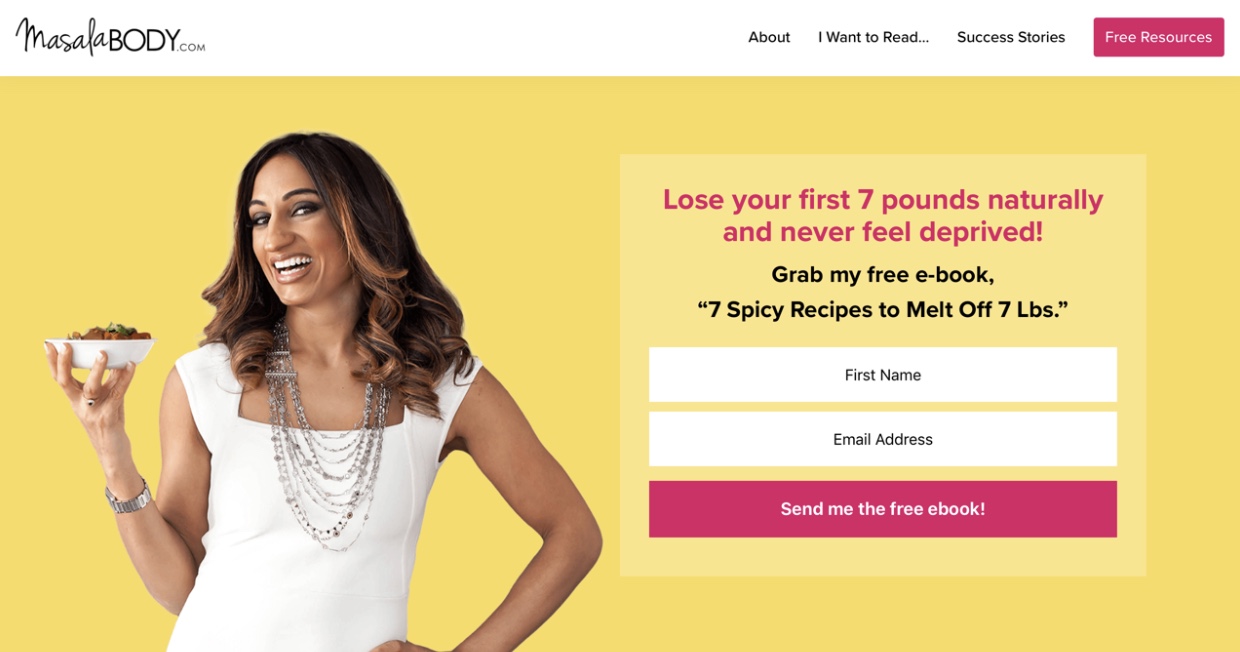
While landing pages can serve a variety of purposes, one in particular is designed only for email capture, and that is squeeze pages. Squeeze pages are intended to capture email addresses from visitors. They offer just enough information to persuade users to fill out the form while keeping their attention focused on that one particular purpose.
As a result, most squeeze pages contain simply the following items (or even fewer):
- A title that both offers a promise and grabs the reader’s attention.
- A subheading that elaborates on the promise.
- The offer’s and the lead magnet’s main advantages.
- The registration form.
- Social proof and trust symbols are examples of additional conversion-boosting factors.
They are, as you can see, far simpler than your typical website homepage. That is precisely why they are so effective. While landing pages can be integrated into your website’s navigation, they are usually used by marketers to acquire leads from external traffic sources such as paid social media campaigns, sponsored mailers, solo advertisements, and various content marketing efforts.
4. Paid ads
While sponsored ads can be used to drive traffic to your squeeze pages, there is another option to capture emails without forcing users to leave the page they are now on.
Lead Ads are what they’re called on Facebook. Google refers to these as Google Lead Form Ads. And you may discover them on LinkedIn as Lead Gen Ads.
Every platform has its own name, but the underlying premise is the same: they provide an easy mechanism for their users to collect emails. And why is it so straightforward? It’s because the platforms fill out the lead capture form with the user’s email address in advance.

While this dramatically enhances conversion rates, there is a drawback. Most of us use our personal email account to access Facebook rather than our workplace email account. And if you want to reach a business-to-business audience, this can be a slight inconvenience.
Final words
That’s it! I hope that this article has provided you with valuable information about how to get started with email marketing. Please feel free to leave comments below for further discussion on this topic!
New Posts

How To Set Up Google Analytics 4 For Your BigCommerce Store






